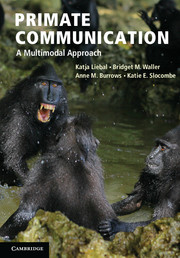Book contents
- Frontmatter
- Contents
- Preface
- Acknowledgements
- Part I Introduction to primate communication
- Part II Approaches to primate communication
- Part III Cognitive characteristics of primate communication
- 6 Acquisition
- 7 Flexibility
- 8 Intentionality
- 9 Referentiality
- Part IV Approaches to the evolution of primate communication
- Glossary
- References
- Species index
- Subject index
9 - Referentiality
Published online by Cambridge University Press: 05 December 2013
- Frontmatter
- Contents
- Preface
- Acknowledgements
- Part I Introduction to primate communication
- Part II Approaches to primate communication
- Part III Cognitive characteristics of primate communication
- 6 Acquisition
- 7 Flexibility
- 8 Intentionality
- 9 Referentiality
- Part IV Approaches to the evolution of primate communication
- Glossary
- References
- Species index
- Subject index
Summary
What is reference?
Humans are very adept at referring to events and objects in the external world, using both gestural and linguistic signals. A large number of human words are referential: they refer to specific entities in the world. In linguistic terms these words ‘stand for’ the external referent and the relation between the physical form of the word and the referent is arbitrary. In language there is usually a one-to-one mapping between a word and its culturally agreed referent(s). Although the referential specificity of words varies greatly (e.g. the number of referents associated with the sign can be small (e.g. banana cake) or large (e.g. food)), the referential meaning is stable and shared between speakers and listeners. In contrast to this, gestural reference, in the form of human pointing, has no one-to-one referential meaning and can only be successfully interpreted by integrating the signal with the shared common ground between signaller and receiver (Liebal et al., 2009; Tomasello, 2008; Tomasello, Carpenter and Liszkowski, 2007). Points direct the attention of the receiver spatially to a location in the immediate perceptual environment, but the referent and meaning of the point can only be decoded by understanding the communicative intent of the signaller. Although this may seem cognitively complex, this ability emerges very early in human development. Humans usually comprehend pointing gestures before their first birthday and start to produce pointing gestures before any spoken words (Bates et al., 1979; Liszkowski et al., 2004; Tomasello, Carpenter and Liszkowski, 2007). Pointing is thought to scaffold the emergence of spoken language in infants. Referential signals in both the linguistic and gestural domains allow humans to direct the attention of others to specific external entities or events and share attention, feelings or thoughts about them, which is fundamental to the complexity of human communication. The extent to which these abilities are uniquely human or shared with other primate species has been a central theme of animal communication research in recent decades.
- Type
- Chapter
- Information
- Primate CommunicationA Multimodal Approach, pp. 194 - 214Publisher: Cambridge University PressPrint publication year: 2013



